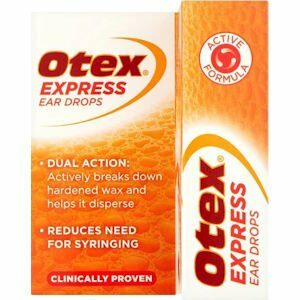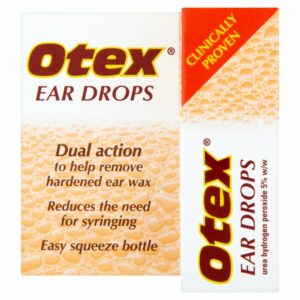Ear
Over-the-counter ear drops offer a convenient solution for various ear health needs, ranging from earwax removal solutions to earplugs that protect from loud noises or water entry, enhancing overall ear well-being. These products are especially formulated for comfort and include natural oil drops for soothing the ear. Read More…

-

EarCalm Spray 5ml
- Relieves Minor Outer Ear Infections
- Anti-Fungal And Antibacterial
- Active Ingredient: Acetic Acid
£7.35 Select options -

Waxsol Ear Drops 10ml
- Active Ingredient: Docusate Sodium
- Helps Relieve Ear Wax Build-up
- Registered UK Pharmacy
£2.79 Add to basket -

Earol Olive Oil Spray 10ml
- Easy to Use
- Softens and naturally Removes Earwax
- Reduces Need For Syringing
£7.09 Add to basket -

Otex Express Ear Drops 10ml
- Actively breaks down hardened wax and helps it break down
- Reduces need for syringing
- Clinically proven
£5.79 Select options -

Otex Ear Drops 8ml
- Treats Ears Blocked With Wax
- Reduces The Need For Ear Syringing
- Active Ingredient: Urea Hydrogen Peroxide
£5.30 Select options -

Exterol 5% Ear Drops 8ml
- Active Ingredient: Urea Hydrogen Peroxide
- Aids Removal Of Hardened Wax
- Next Day Delivery Available
£4.49 Select options -

Bicarbonate Ear Drops 10ml
- Gently softens ear wax
- For use before ear syringing
- Doctor may recommend using before appointment
£2.89 Select options -

-

Cerumol Olive Oil Ear Drops 10ml
- Naturally Gentles & Softens Ear Wax
- Buy With Confidence From UK Registered Pharmacy
- Next Day Delivery Available
£6.09 Add to basket -

Numark Olive Oil Ear Drops 15ml
- Easy to Use
- Softens and naturally Removes Earwax
- Reduces Need For Syringing
£2.79 Add to basket -

Quies Foam Earplugs
- Easy to Use
- Suitable For Children
- Effective At Blocking Out Loud Noise
£4.99 Add to basket -

Earex Advance Ear Drops – 12ml
- Dual action formula softens and removes hard earwax
- Helps to reduce the need for syringing
- Helps prevent hardened earwax build up
£6.99 Add to basket
-
About
Ear conditions can stem from various issues and may affect not only the ear but also connected structures like the neck, sinuses, or head. The spectrum of ear diseases is broad, ranging from infections and inflammations to structural and sensorineural disorders.
One of the most prevalent types of ear conditions is otitis media, which impacts the middle ear and leads to fluid build-up behind the eardrum, potentially causing swelling and pain. Such infections are often resolved with antibiotics and, if recurrent, may require surgical intervention like ear tube placement. On the other hand, otitis externa, commonly known as swimmer’s ear, is an infection of the outer ear canal and is typically treated with topical antibiotics.
Age-related hearing loss, known as presbycusis, is characterised by gradual hearing deterioration, often starting with difficulty hearing high-pitched sounds. While irreversible, its progression can be managed with hearing aids or, in more severe cases, cochlear implants.
Conditions like vestibular neuritis, resulting from viral infections, cause severe dizziness or vertigo and are usually self-resolving but may require symptomatic treatment for relief. Ménière’s disease, associated with the build-up of fluid in the inner ear, also manifests with vertigo along with hearing loss and tinnitus, and is managed with medications to alleviate dizziness and lifestyle changes to mitigate symptoms.
Barotrauma is a condition resulting from pressure changes, commonly experienced during air travel or diving, leading to ear discomfort and possible temporary hearing loss. Simple actions like yawning or chewing gum can alleviate the pressure differences and relieve symptoms.
-
Symptoms
Symptoms of common ear conditions include:
Chronic discharge from the ear, possibly yellowish, greenish, or bloody.
Ear pain, redness, and inflammation.
A feeling of fullness or pressure in the ear, often related to eustachian tube problems.
Vertigo or severe dizziness, as seen in conditions like vestibular neuritis or Ménière’s disease.
Nausea and vomiting, which may accompany vertigo.
Hearing loss, ranging from mild and temporary to progressive and permanent.
Tinnitus, characterised by the perception of ringing or noise in the ears without an external source.
Difficulty hearing certain frequencies, like high-pitched sounds, often an early sign of age-related hearing loss (presbycusis).
Popping sounds in the ears, especially related to changes in pressure (barotrauma).
Facial muscle paralysis or dizziness, in severe cases of middle ear disorders like cholesteatoma.
Pain, swelling, and redness around the ear cartilage, indicating perichondritis.
If you experience any of these symptoms, it is recommended to consult with a healthcare professional for an accurate diagnosis and appropriate treatment
-
Diagnosis
Diagnosis of common ear conditions usually involves the following steps:
Review of Symptoms: The healthcare provider will ask about the symptoms, their duration, and any related factors.
Physical Examination: A general examination to check for signs of related health issues or contributing factors.
Ear Examination with an Otoscope: The provider uses a lighted instrument called an otoscope to view the eardrum and ear canal. Inflammation, redness, or swelling of the eardrum can indicate an infection.
Pneumatic Otoscopy: This test involves blowing a puff of air onto the eardrum using a pneumatic otoscope to check for fluid in the middle ear. The eardrum’s movement is assessed; restricted movement suggests the presence of fluid.
Tympanometry: This test uses air pressure to detect fluid in the middle ear, measuring the eardrum’s response to pressure changes.
Acoustic Reflectometry: Sound waves are used to evaluate fluid presence in the middle ear.
Tympanocentesis: In certain cases, fluid may be removed from the middle ear to test for bacteria or viruses.
Hearing Tests: Conducted by an audiologist, these tests determine if there is any hearing loss, which is common in children with frequent ear infections or persistent fluid in the middle ear.
If a more severe or persistent condition is suspected, referral to an ear, nose, and throat (ENT) specialist may be recommended for further assessment and treatment options. Regular monitoring and follow-up appointments are crucial for managing ongoing conditions or repeated infections.
-
Treatments
Over-the-counter (OTC) ear medications offer relief and treatment for various ear conditions, with each type of ear drop tailored to address specific symptoms or issues:
Ear Drops for Ear Infections: For ear infections, such as otitis media (inner ear infection) or swimmer’s ear (otitis externa), healthcare providers may recommend antifungal or antibiotic ear drops. Common active ingredients include acetic acid, ciprofloxacin, ofloxacin, tobramycin, and gentamicin. While antifungal drops may be available OTC, antibiotic ear drops require a prescription.
Swimmer’s Ear Drops: These are designed to treat infections in the outer ear, usually caused by bacteria or fungi. Ear drops for swimmer’s ear often contain a combination of an acidic solution to restore the ear’s antibacterial environment, steroids to reduce inflammation, antibiotics or antifungals to treat the infection, and sometimes alcohol or vinegar to help dry out the ear.
Ear Drops for Pain: If ear pain is an issue, OTC pain relief ear drops are available.
Earwax Removal Drops: For earwax buildup, ear drops can soften and loosen earwax for easier removal. These might contain ingredients like carbamide peroxide, hydrogen peroxide, glycerin, or sodium bicarbonate.
Ear Drops for Itchy Ears: Corticosteroid ear drops are prescribed when itchiness in the ears is not caused by an infection. If there is an infection, antifungal or antibiotic drops will also be needed.
Using ear drops properly can enhance their effectiveness. It’s important to warm the bottle in your hand before administering, lie down with the affected ear facing up, and after placing the drops, remain lying on your side for a few minutes to let the medication reach deeply.
At My Pharmacy, we’re highlighting these over-the-counter ear medications for their effectiveness in treating various ear-related conditions:
EarCalm Spray (5ml): This spray contains acetic acid and offers relief from minor outer ear infections, with antibacterial and antifungal properties.
Waxsol Ear Drops (10ml): Formulated with docusate sodium, these drops aid in relieving earwax build-up and are a registered UK pharmacy product.
Earol Olive Oil Spray (10ml): An easy-to-use spray that softens and naturally removes earwax, reducing the need for syringing.
Otex Express Ear Drops (10ml): These drops are designed to actively break down hardened wax, aiding its removal and reducing the need for syringing, and are clinically proven.
For conditions like swimmer’s ear, maintaining a dry ear environment is key to preventing infection. If symptoms persist or worsen after using OTC ear drops, a healthcare provider should be consulted. It’s also crucial to note that some conditions may resolve on their own, but severe or persistent symptoms should be evaluated by a professional to determine the necessity of prescription medication or further treatment.
-
Prevention Strategies
To prevent ear infections and maintain ear health, consider the following strategies:
Frequent Handwashing: Regular hand washing can help prevent the spread of germs that lead to ear infections.
Healthy Habits: Eating a balanced diet, getting adequate sleep, and maintaining overall health can bolster your immune system.
Avoid Smoke Exposure: Ensure smoke-free environments at home and in public spaces to reduce the risk of ear infections.
Appropriate Feeding Techniques: For infants, breastfeed, if possible, for at least six months, as breast milk can provide antibodies against ear infections. If bottle-feeding, hold your baby upright to prevent milk from entering the eustachian tubes.
Vaccinations: Stay updated with recommended vaccinations, including seasonal flu shots and the pneumococcal vaccine, which can help prevent ear infections.
Eustachian Tube Function: Activities that promote regular eustachian tube function, like chewing gum and yawning, may help equalise ear pressure.
Dry Ears: Keep ears dry and clean, especially after swimming or bathing, to prevent swimmer’s ear.
Limit Group Child Care: If possible, limit children’s time in large group settings where germs are more likely to spread.
These preventive measures can significantly reduce the risk of developing ear infections. It’s also important to consult a healthcare provider for the appropriate vaccinations and to discuss any concerns regarding ear health or infection prevention.












